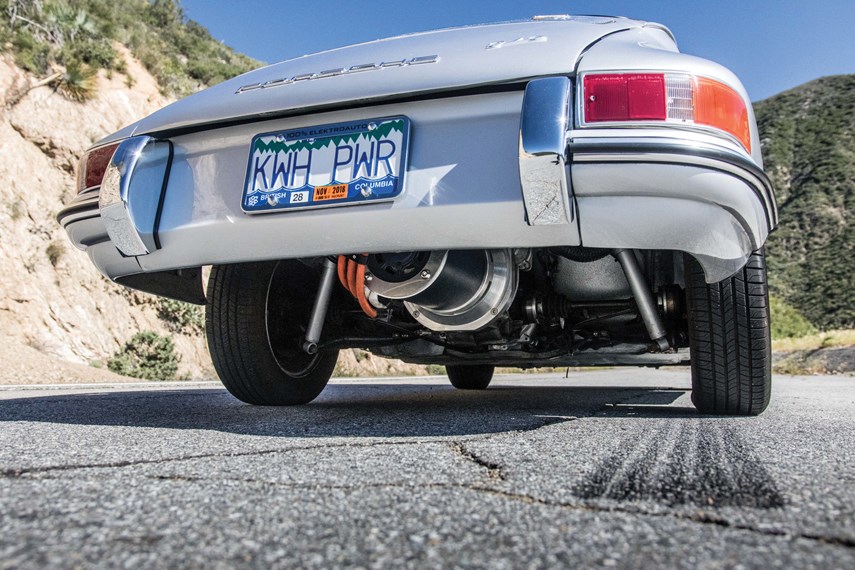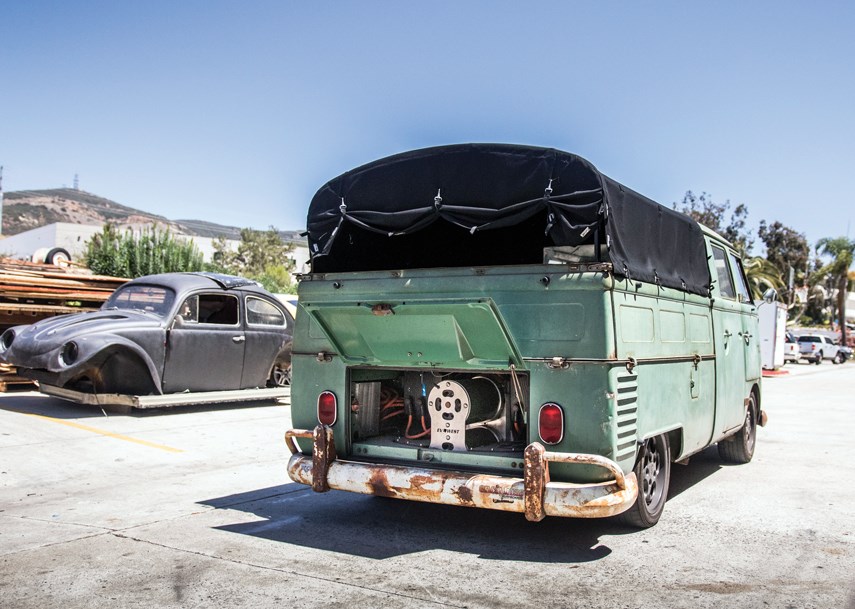Luftgekühlt, held for the past five years in California, has grown into perhaps the premiere car show for all things Porsche and air-cooled.
The price of entry isn’t all that high – you can get in with a four-cylinder 914 or 912, or just spectate for about $35 – but the pool of wealth that’s interested in collecting old Porsches attracts all kinds of high-rollers.
I went this year, and bumped into Chad McQueen, the guy who owns WeatherTech floormats (they just bought Laguna Seca), and Bruce Canepa, who will sell you a $2.5-million reworked Porsche 959. They were all very pleasant to chat with, and none seemed to notice the whiff of heresy I carried with me.
You see, just the previous day I had been squiring around Angeles Crest highway in a machine that would have had Porsche fans burning me at an air-cooled stake: a gorgeously restored Porsche 912, converted to electric power. The look was pure 1960s, but the drivetrain was lifted from a wrecked Tesla.
To drive, it was simply excellent. Because the car retains that classic Porsche five-speed manual, there was still a level of driver involvement, albeit without the air-cooled soundtrack that so many love. The 912 EV also had three times the power as when it was powered by a 1.6-litre flat-four, and the front-mounted battery placement gave the little car better balance. It also wasn’t really much heavier than an ordinary classic, clocking in at about the same as a 1960s 911S with a full tank of fuel.

Throw in reworked suspension, modern tires, and regenerative brakes, and the electro-Porsche could hustle hard through the canyon roads. On the uphill, power dropped fast, but battery levels came right back up on the way back down the mountain. It wasn’t entirely silent either, with a fizzing sci-fi whizz accompanying every firm throttle application.
To get a closer look at what goes into the creation of something like this, I popped over to EV West, who’d built the 912’s current layout. There, I had the opportunity to drive a similarly electrified VW Microbus, and go for a spin in a classic Porsche 356 Speedster with Tesla bits swapped in for the oily engine.
EV West is located just north of San Diego in an industrial complex, and has a medium-sized array of solar panels on the roof. If you work here, you can charge your car for free and run on sunshine; most of the employees do.
But rather than featuring posters of, I don’t know, granola manufacturers, EV West was absolutely your typical SoCal speed shop. Every person there was a gearhead, and out back were the rubber remnants of someone having done a massive burnout after hours.
Here, electric power isn’t heresy, it’s just another way to power a classic car. EVs aren’t great for long range yet, and a cheap build can be heavy. If you’re willing to sink a little more money into it, it’s easy to have around 200+ kilometres of range in a car that’s not much heavier than the original. With the EV swap, the cars are far quicker, far more reliable, and don’t disturb a single pedestrian.
As a wooden-shoe carrying Luddite, I wasn’t sure how to feel about all this electro-trickery. I grew up under the hoods of British cars, with dirty fingernails and split knuckles. Nothing takes me back to my youth more than a faint whiff of petroleum products when lifting a sandwich to my mouth.
And then there’s the loss of sound, that most elemental of driving pleasures. Almost all the great cars stir the soul with syncopated explosions, where an electric-powered machine sounds like the USS Enterprise on a good day, or simply like nothing at all.
However, if you can’t find pleasure in slightly drifting a lowered VW bus around corners, then maybe you’re being a little close-minded. Further, I was heartened to find out that every one of EV West’s creations could be converted back to original spec in less than a day’s work. The original integrity of the cars were preserved, even though the powertrains were changed.

At this year’s All British Field Meet held at Vancouver’s VanDusen Botanical Garden, I was privileged to judge a few machines out of the modified class, including a Ford Escort swapped with a Honda S2000 drivetrain, and an MGB with a V-8 stuffed underhood. Neither was what you’d call period-correct, but both were pretty hairy. If you’ve got gasoline in your veins, you couldn’t help but love them.
The electric-swapped classic is a much harder sell, spurned by those who feel it changes too much of the character of the car. However, most of those who look down their noses haven’t actually driven one, and are merely projecting. “They must feel like golf carts,” is a common reaction.
It’s a mistake to turn away from something simply because it falls outside what you’re used to. An electrified Porsche 356, especially one of the Intermeccanica tribute cars built here in Vancouver, would be a nearly ideal machine as a city car. You’d have access right up the Sea-to-Sky highway, and the ability to jump in and go for an early morning toodle without waking the neighbours. Our glittering city of glass would be your own personal playground.
Sometime in the future, the last gallon of gas will sit in a museum somewhere, a relic of a bygone age. But that doesn’t mean the great cars of the past will be lost to time. There’ll be a mix of drivetrains powering classic cars; plenty of Volkswagen and Porsche products are relatively common and pretty slow by modern standards, making them ideal candidates for an electric swap.
For those inside Luftgekühlt, there are rules. For those on the outside, there aren’t. While I’ll agree that heritage is important and should be preserved, there’s nothing wrong with a little heresy now and then.
Brendan McAleer is a freelance writer and automotive enthusiast. If you have a suggestion for a column, or would be interested in having your car club featured, please contact him at [email protected]. Follow Brendan on Twitter: @brendan_mcaleer.



